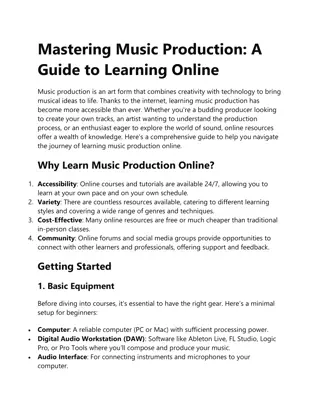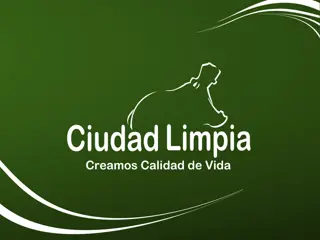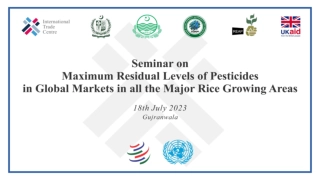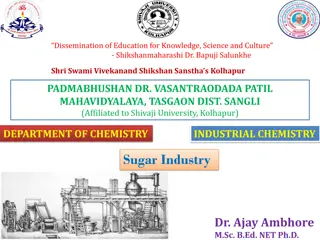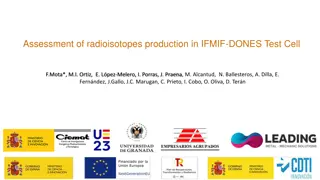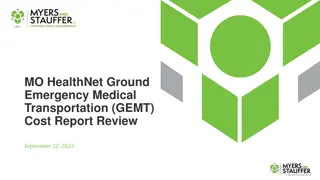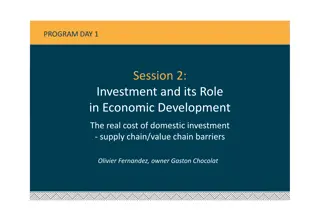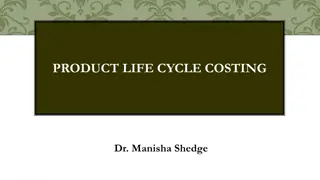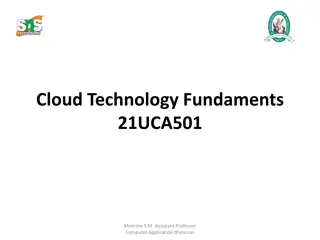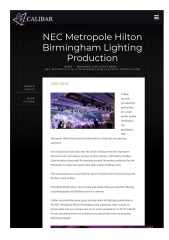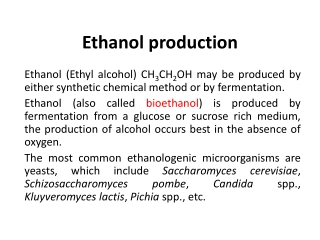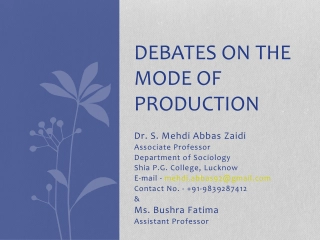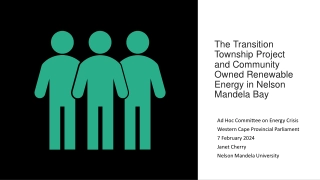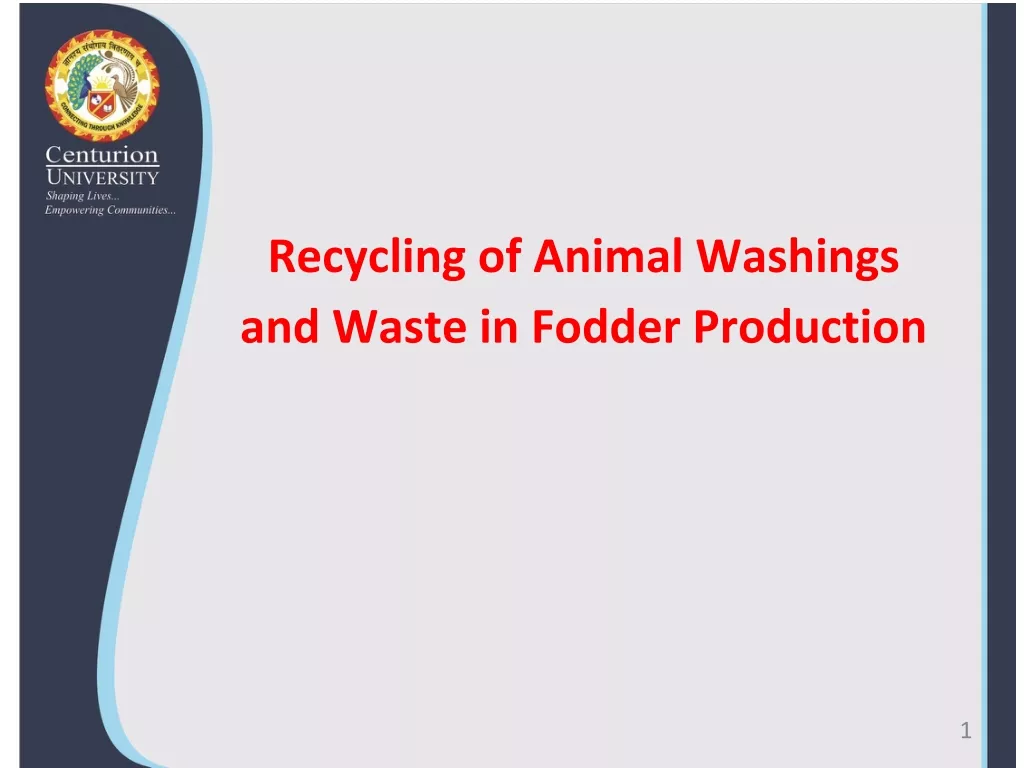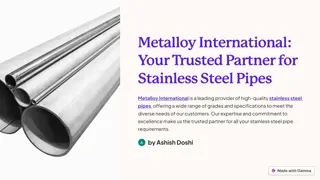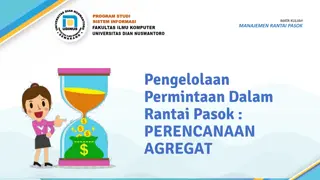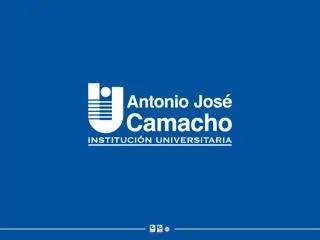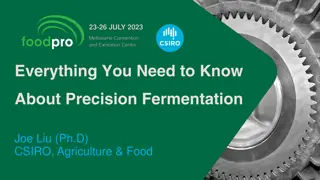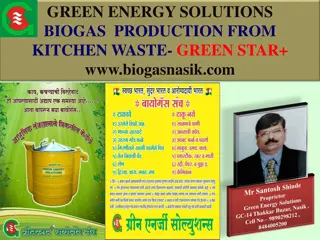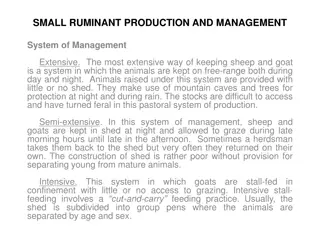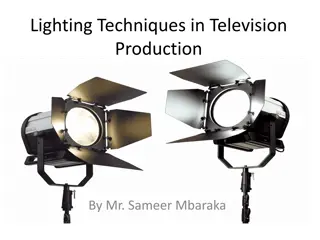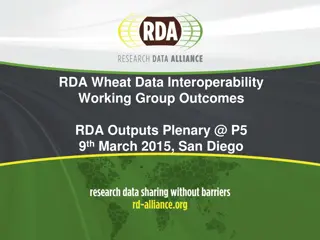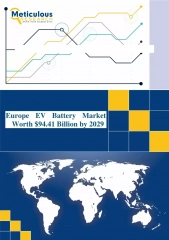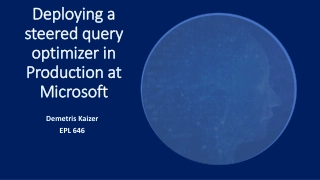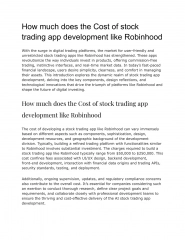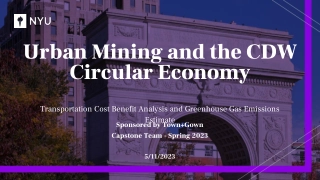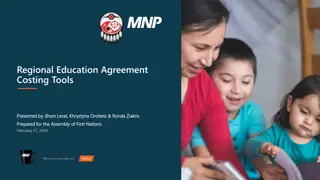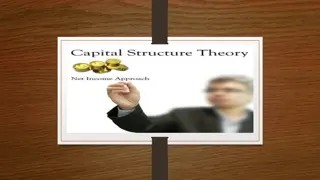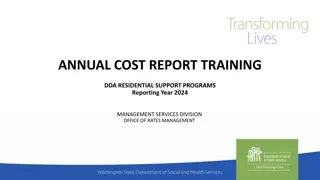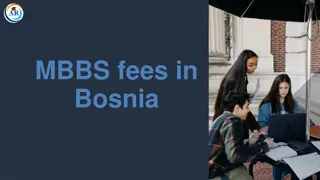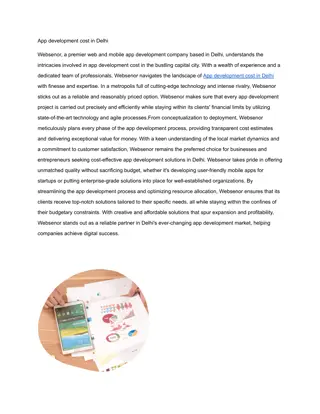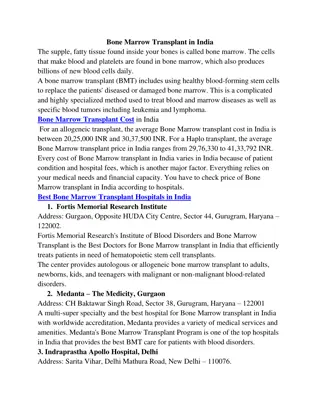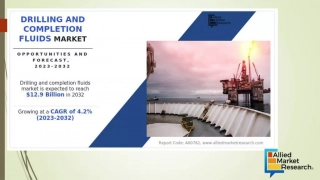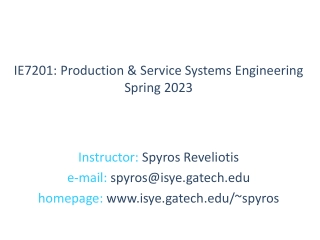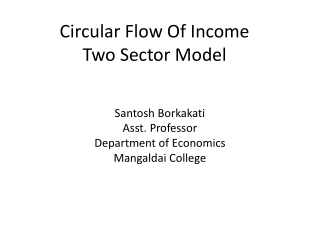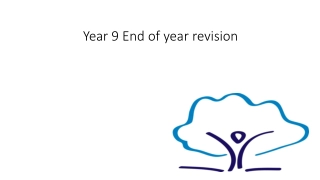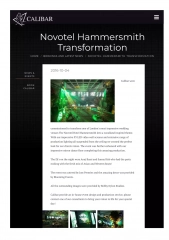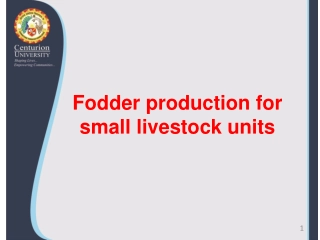Cost Of Production
Explore the concepts of production cost analysis, focusing on total fixed costs, total variable costs, total cost of production, average cost, and average fixed cost. Learn how these costs behave in the short run and their impact on a firm's operations.
Cost Of Production
PowerPoint presentation about 'Cost Of Production'. This presentation describes the topic on Explore the concepts of production cost analysis, focusing on total fixed costs, total variable costs, total cost of production, average cost, and average fixed cost. Learn how these costs behave in the short run and their impact on a firm's operations.. Download this presentation absolutely free.
Presentation Transcript
Cost Of Production Duna Jogeswar Rao
Production Cost Curve (Short Run) Total Cost of Production (TC) Average Cost of Production(TC) Total fixed cost of production (TFC) Average Fixed Cost (AFC) Total Variable Cost of Production (TVC) Average Variable Cost of Production (AVC)
Total fixed cost of production (TFC) Fixed costs are amount spent by the firm on fixed inputs short-run. Fixed costs are, thus, those costs which remain constant, irrespective of the level of output. These costs remain unchanged even if the output of the firm is nil. Fixed cost therefore, are known as supplementary costs or overhead costs. The concept of Fixed Cost is associated with the short run only. Total Fixed Cost (TFC) (in Rs.) Units of Output 0 200 1 200 2 200 3 200 4 200 5 200
Total Variable Cost of Production (TVC) Total variable costs are those costs incurred on variable factors . These costs vary directly with the level of output . In other words , variable costs are those costs which rise when output expands and fall when output contracts . When output is nil , they are reduced to zero .
Total Cost of Production (TC) Total Cost includes both total fixed cost and total variable cost. It may also called as total cost of Production. TC= TFC+TVC
Average Cost (TC) According to Dooley, "The average cost of production is the total cost per unit of output." In other words average cost of production is the total cost of production divided by the total number of units produced . Suppose , the total cost of producing 500 units is 1,000 , the average cost will be : Average Cost (AC) = Total Cost/Output= 1000/500= Rs. 2 Average cost is shown in Fig.4. In this figure, output is measured on OX-axis and cost on OY-axis. AC curve represents average cost. It resembles English alphabet 'U'. It means that with increase in output initially average cost falls but after having reached its minimum, it begins to rise as the output increases. In short period average cost is the sum total of average fixed cost and average variable cost, i.e., AC=AFC+AVC
Average Fixed Cost (AFC) Average fixed cost can be obtained by dividing total fixed cost by the quantity of output . It is also called average fixed cost of production . AFC = TFC/Q (Here Q stands for Quantity) behaviour of AFC: (i) as output increases AFC goes decreasing. This is why , AFC curve is a downward sloping curve . (ii)average fixed cost curve slopes downward with a view to touch the horizontal axis . But it will not be so because AFC can never be zero . Thus , it is clear that as output increases average fixed costs go on diminishing . Average fixed cost curve is a rectangular hyperbola. The total area under the curve at different points will be the same.
Average Variable Cost of Production (AVC) The average variable cost is the variable cost per unit of output. It is obtained by dividing the total variable cost by the total output. BEHAVIOUR OF AVERAGE VARIABLE COST (AVC) It will be observed from the above table 6 that average variable cost declines initially upto 26.6, its minimum point. After that it start rising. It shows that in the initial stages law of decreasing cost (law of increasing return to variable factor) is applying, finally the operation of law of increasing cost or diminishing return is clearly visible. 1. AVC curve is always U - shaped ( dishshaped ) showing the behaviour of declining cost in the initial stages and finally. 3. AVC shows almost the tendency of TVC , AVC like is also based upon the laws of returns . 2.
Marginal Cost The concept of marginal cost of production is recently developed by Austrian School of Economics. Marginal cost is an addition to the total cost caused by producing one more unit of output . According to Ferguson, "Marginal cost is the addition to total cost due to the addition of one unit of output." According to Samuelson, "Marginal cost at any level of output is the extra cost for producing one extra unit more or less. MC = TC/ TQ
Relation between Average and Marginal Cost Both AC and MC are calculated from TC 1. 2. When AC falls, MC also falls When AC rises, MC is also rising 3. MC cuts AC at its lowest point 4. For a brief stretch, AC may continue to decline even when MS is rising 5. 6. Mutual interaction between MC and AC
Relationship of different cost curves in the short period Average fixed cost ( AFC ) curve is continuously falling down . AVC is average variable cost curve . It first declines reaches a minimum at point S , and rises thereafter . It is also of U - shaped which is not so pronounced as of AC curve , when AVC attains its minimum at point S , marginal cost ( MC ) equals AVC . It may be noted that the distance between short period ayerage cost and average variable cost becomes narrower as more and more output is produced . This distance , as a matter of fact , is equal to average fixed cost . AC is short period average cost curve . It first declines , reaches a minimum at point T and gradually rises thereafter . In other words , it is U - shaped , when AC attains its minimum at point T , MC equals AC . Minimum point S of AVC occurs earlier than the minimum point T of AC .
Relationship of different cost curves in the short period MC is short period marginal cost curve . It is also U - shaped . It means it first decline reaches a minimum at point S and rises thereafter. MC curve cuts both AVC curve and AC curve at their minimum points . Furthermore MC lies below AVC and AC when they are declining , it lies above them when they are rising . The relationship between AVC, AC and AFC can be summed up as follows: (i) If both AFC and AVC fall , AC will also fall because AC = AFC + AVC . (ii) When AFC falls and AVC rises (a) AC will fall where the drop in AFC is more than the rise in AVC , (b) AC remains constant if the drop in AFC = rise in AVC , (c) AC rise where the drop in AFC is less than the rise in AVC .
Cost Curve in the Long Period The long period is defined as a period of time which is sufficient to bring about proper changes in the scale of output through an adjustment of the quantity of the various factors employed. The quantity of all the factors can be increased or decreased according to the requirements of production . Thus , in the long - run all factors are variable. There is nothing like the fixed cost of production. Since in the long - run , there would be no distinction between fixed and variable costs, we shall be interested only in long - run average cost curve ( LAC ) and long - run marginal cost curve ( LMC ).
Long Run Average Cost Curve Long - run average cost refers to minimum possible per unit cost of producing different quantities of output in the long period . Definition: In the words of Mansfield, " The long - run average cost curve is that curve which shows the minimum cost per unit of producing each output level . Corresponding to different scales of productivity. " It is determined by dividing long - run total cost by the quantity of output produced . It is the lowest average cost attainable when all inputs are variable; that is when any plant size can be constructed .
Elaboration Suppose there are three different plants available and for the sake of simplicity we name them as SACx , SACy and SACz . To produce say 1000 units of the unit cost on SACx is Rs. 200 while on SACy it is Rs.120 and on SACz is Rs. 320. But, to produce say 2000 units, average cost on plant SACy is Rs. 180 while it is Rs. 280 on SACz but Rs. 300 on SACx. Similarly, to produce say 3000 units, average cost is lowest on plant size SACy. choose plant SACx where AC is lowest . However if decides later to produce 2000 units , it has the option to produce 2000 units on plant SACx or alternatively to choose plant SACy , where AC is ? 180 . If the firm decides to produce 1000 units only . It is profitable to
Elaboration Thus , in the long run a producer or a firm has a choice in the selection and use of plant where it will select that where per unit cost is minimum at a given level of output . Now suppose instead of just three plant sizes , there were many plants available , each capable for producing a different level of output . In such a case we shall be able to obtain the points of intersection of consecutive plants and obtain the LAC . The LAC is the locus of points representing the least unit cost of producing different outputs . The LAC curve can , therefore be defined as the lowest possible average cost of producing any output when the management has adequate time to make all desirable changes and adjustments . The LAC curve is sometimes called the ' normal cost ' curve or the ' planning curve ' of a firm . It is called the planning curve because it enables a firm to plan its size . Long - run average cost curve is also defined as an ' envelope ' curve , since it envelops all the short - run average cost curves . However , opinions differ as to this nomenclature of LAC curves , Stonier and Hague observe :
Main Features of the LAC Curve By joining the locus of various plant curves relating to different operational short - run phases , the LAC curve is drawn as a tangent curve. The LAC is tangent to the whole set of SAC curves relevant for different plant sizes. It touches the minimum of the SAC curves only in the special case of constant returns The LAC can never cut a SAC curve ( though they are tangential to each other ) . This implies that for any given output , average cost cannot be higher in the long - run in the short run LAC curve will touch the ' optimum scale ' curve at the latter's least - cost point . LAC curve will touch SAC curves lying to the left of the optimum scale curve at the left of their least - cost points . LAC curve will touch SAC curves lying at the right of the optimum scale curve at the right of their least - cost points . LAC curve will also tend to be U - shaped just as the short - run average cost curve . But it will be less pronounced in U - shape and will be more flatter than short - run ones . This is because in the long run , such economies are possible as cannot be had in the short - run . Likewise , some of the diseconomies , which are faced in the short - run , may not be faced in the long - run .
Long Run Marginal Cost Change in the total cost , in the long - run due to production of one more or one less unit of commodity is called long - run marginal cost . Definition: In the words of Ferguson , " Long - run marginal cost is the addition to total cost attributable to an additional unit of output when all inputs are optionally adjusted ." Long - run Marginal Cost ( LMC ) = Change in Long - run Total Cost ( LTC ) /Change in Output ( Q )
Relation between LMC and LAC The LAC and LMC curves will behave in the same way as the SAC and SMC curves , i.e. , So long as the LAC curve is falling the LMC curve will lie below the LAC curve. So long as the LAC curve is rising , the LMC curve will be rising and will lie The LMC curve will intersect the LAC from below and at its minimum point. This property follows (i ) and ( ii ) above . Usefulness of LAC curves : The usefulness of LAC curve lies in its ability to assist the firm in the determination of the best size of the plant to be adopted for producing the given output . For outputs less than the low - cost combination at the optimum scale , that is , when the firm is operating subject to increasing returns to scale it is more economical to underuse a slightly larger plant operating at less than its minimum cost output to overuse a smaller plant . Conversely , at outputs beyond the optimum level , that is , when the firm experiences decreasing returns to scale , it is more economical to overuse a slightly smaller plant than to underuse a slightly larger one .
Modern Theory of Long Run Costs In the modern theory of long - run costs it is argued that the LAC curve is L - shaped rather than being U - shaped. The experience of the actual world do not support the assumption of a 'U' shaped long run average cost curve. This shape is based on the assumption that there is no technological improvement which is cost effective over a long period. The empirical evidence shows that with the passage of time, there is improvement in cost of production (i.e., it reduces) due to technological advancement. In that case, every successive short run cost curve will be below the former. This will give a shape of LAC which will be similar to english letter ' L '.
Technological Development One reason why empirical studies do not bear out the U-shaped curves of economics theory may be that the theory assumes that there is no technological development, while in practice there is. The existence of technological development might explain why one would find L - shaped long - run average cost curves in empirical studies , even in a world where long - run average cost curves would be U shaped if there were no technical progress . This is explained in this fig. operating on LAC1 ,. If the demand for the firm's product increases to OM2 , then the firm will expand production along LAC1 , and will produce OM2 , at cost OB. If technological progress is occurring, it may be possible to produce an output of OM2 , with newer plant that has the long - run average cost curve LAC2 . Here , average cost for an output of OM2 , is only OC . Suppose initially the firm is producing OM1 , output at cost OA by
Learning by doing Learning by doing is another factor which causes the LAC to slope downward throughout . The idea behind learning ' is that practice makes a man perfect There is a good deal of evidence to show in case of expensive , complex products such as aircrafts , ships , and electronic products that the cost of product depends on the aggregate amount of products produced since the firm first began to make it . Besides , the learning phenomenon has been found to operate in several other industries such as electric power generation , oil - refining steel industry , etc. such as less time to instruct workers , improved management controls , better operation sequences , machine - feeds and speeds , improvements in machines and tooling , more skilful movements of workers , and less rejection and rework . The effect of learning on production comes through several kinds of improvements
COST REDUCTION Cost reduction has been defined by the Institute of Cost and Works Accountants of London as the achievement of real and permanent reductions in the unit costs of goods manufactured of services rendered without impairing their quitability for the use intend.
Tools and Techniques of Cost Reduction Management Audits Target Costing Total Quality Management (TQM) Bench Marketing Reducing non-essential spending Taking Control of third-party spend Tackling the company s cost culture and behaviours
COST CONTROL Cost control is different from cost reduction . The word Control' indicates on exercise in restraint. When expenses are controlled, they are restrained from grow. Cost control implies controlling the costs at the given level. Cost control does not mean mechanical cost reduction. It means better management of material purchase, effective organization of factors of production etc., cost control aims at keeping the cost of production at a manageable limit. whether actual costs are in line with budgeted costs and to correct discrepancies by limiting actual costs or adjusting budgeted costs. Cost control is necessary for business to stay within budget , and to adapt to changing profit or cost conditions. In short , the cost control is the practices and policies used by businesses to determine
Steps Involved in Cost Control Establishment of Standards Cost Analysis Comparison of Cost Monitoring the process Implementing the Approach


